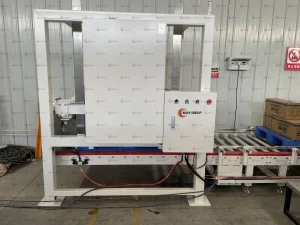In the fast-evolving world of modern manufacturing, the question isn’t whether palletizing robots can be integrated into production lines — it’s how soon you’ll do it. From factories producing food and beverages to plants packaging electronics, robotic palletizers are quietly transforming the backbone of production efficiency.
If your facility still relies heavily on manual stacking or outdated automation, it’s time to explore how integrating palletizing robots into your production line can revolutionize your operations. This post will walk you through the benefits, integration methods, challenges, and real-world ROI of robotic palletizers — with clear, actionable insights that will help your business stay ahead of the curve.
1. What Is a Palletizing Robot?
A palletizing robot is a type of industrial robot designed to automatically stack products, boxes, or bags onto pallets in an organized pattern. It replaces or assists manual labor in repetitive lifting tasks, ensuring accuracy, speed, and consistency.
- Modern palletizing robots come in various types — articulated arm robots, gantry systems, and collaborative robots (cobots) — each tailored to different production setups.
- Articulated robots are best for heavy loads and complex pallet patterns.
- Gantry robots excel in high-speed operations with fixed paths.
- Cobots are ideal for flexible lines requiring human-robot collaboration.
palletizing robots
2. Can Palletizing Robots Be Integrated Into Existing Production Lines?
Yes — absolutely. Palletizing robots can be integrated into nearly any production line, regardless of size, layout, or industry. Modern robotic systems are designed to be modular and flexible, meaning they can connect seamlessly with conveyors, packaging machines, vision systems, and even ERP software.
Here’s how integration typically works:
- Assessment Phase: Engineers evaluate your current workflow and palletizing needs.
- System Design: The robot’s reach, payload, and end-of-arm tooling (EOAT) are customized.
- Simulation: A virtual layout ensures compatibility and efficiency before installation.
- Integration: The robot connects to your production line’s PLCs and conveyors.
- Training & Optimization: Operators are trained, and the system is fine-tuned for maximum performance.
3. Why Integrate Palletizing Robots Into Your Production Line?
The advantages go far beyond labor savings. Let’s look at the top benefits:
Increased Throughput
Palletizing robots operate continuously without fatigue, increasing line efficiency by 20–40% on average.
Consistent Quality
No more misaligned stacks or damaged goods. Robots deliver millimeter-level accuracy in every cycle.
Labor Optimization
With a global shortage of skilled labor, automating palletizing allows staff to focus on higher-value tasks like quality control and logistics.
Improved Safety
Palletizing is one of the most injury-prone tasks. Robots eliminate repetitive lifting and reduce workplace accidents by up to 70%.
Scalability
Need to increase production? Robots can easily be reprogrammed to handle new product sizes or pallet patterns without expensive modifications.
4. Common FAQs About Robotic Palletizing Integration
Q1: Is my production line too small for a palletizing robot?
Not at all. Compact robotic palletizers are designed for low to medium output facilities. Even small manufacturers are realizing quick ROI — often within 12–18 months.
Q2: Will integration cause production downtime?
Minimal. Most integrations are completed in 2–4 weeks, and simulation tools ensure a smooth transition.
Q3: Do palletizing robots work with mixed product lines?
Yes. With advanced vision and software control, robots can identify and handle multiple SKUs in the same cycle.
Palletizing robots aren’t just for massive factories anymore. Whether you’re running a small workshop or a high-speed production line, robotic palletizing integration can cut costs, boost safety, and future-proof your business.


